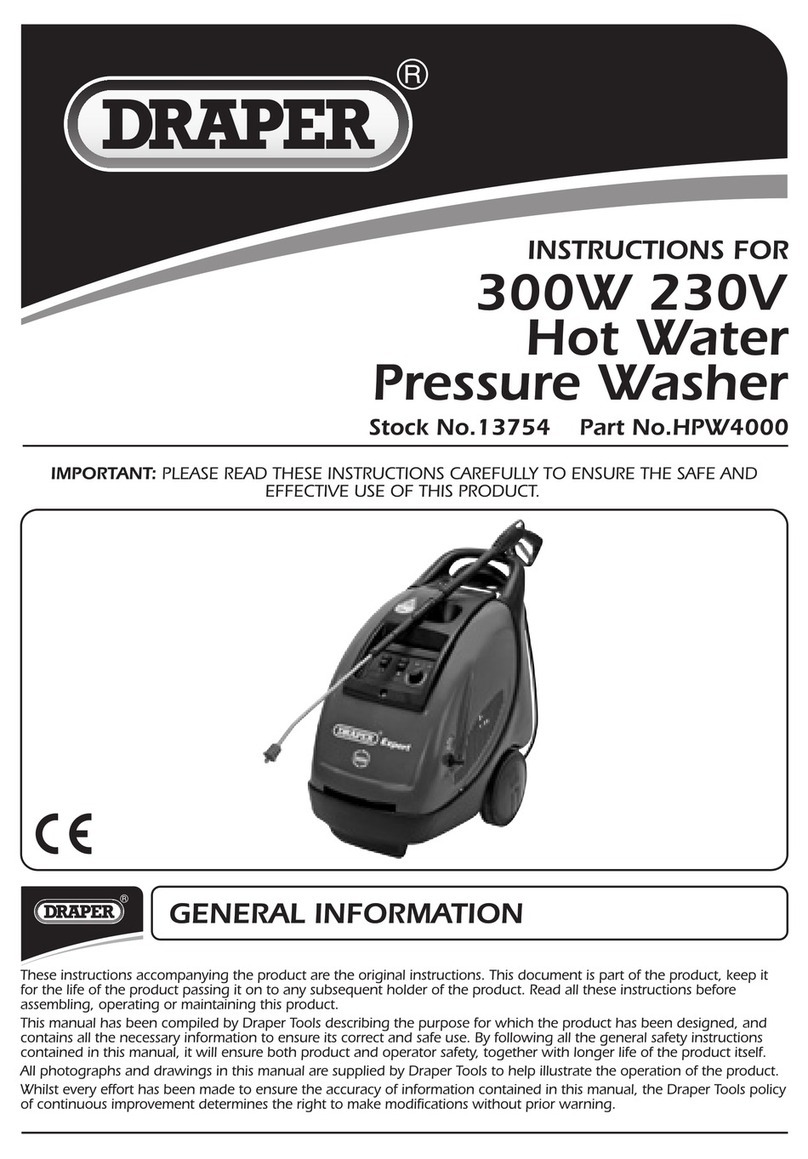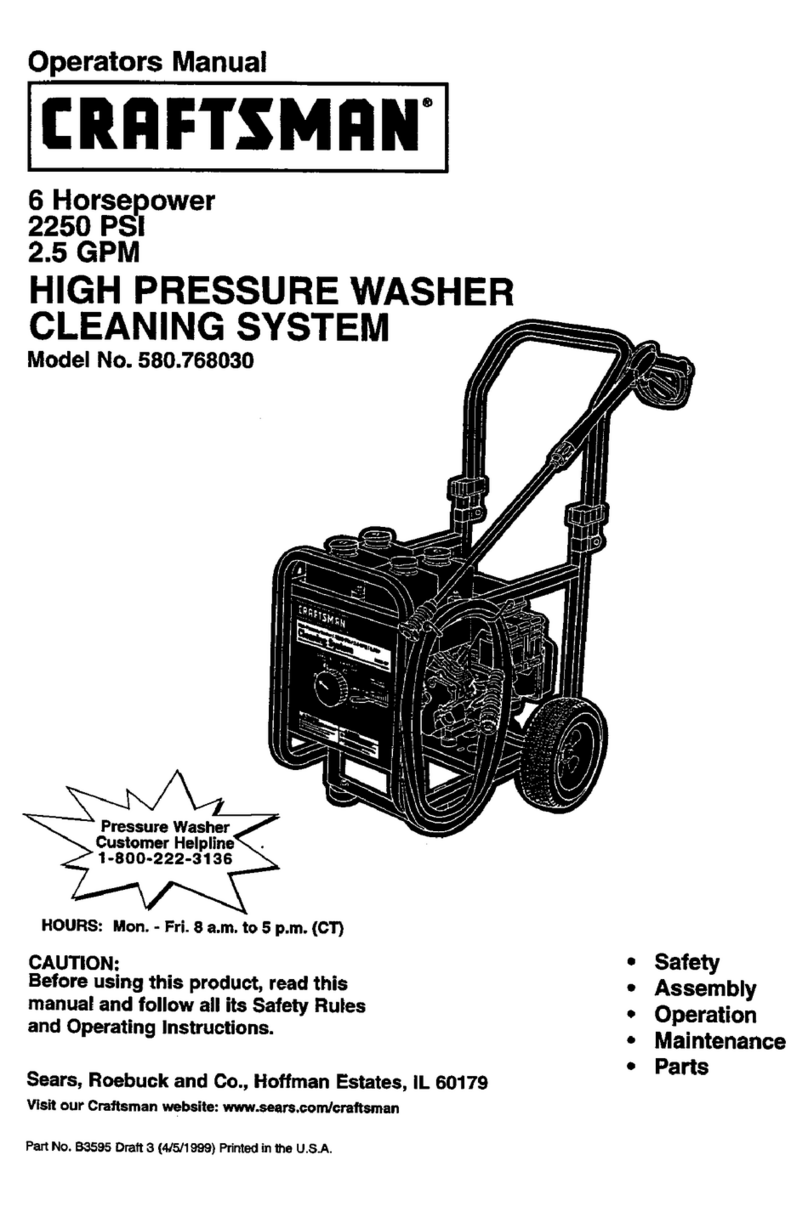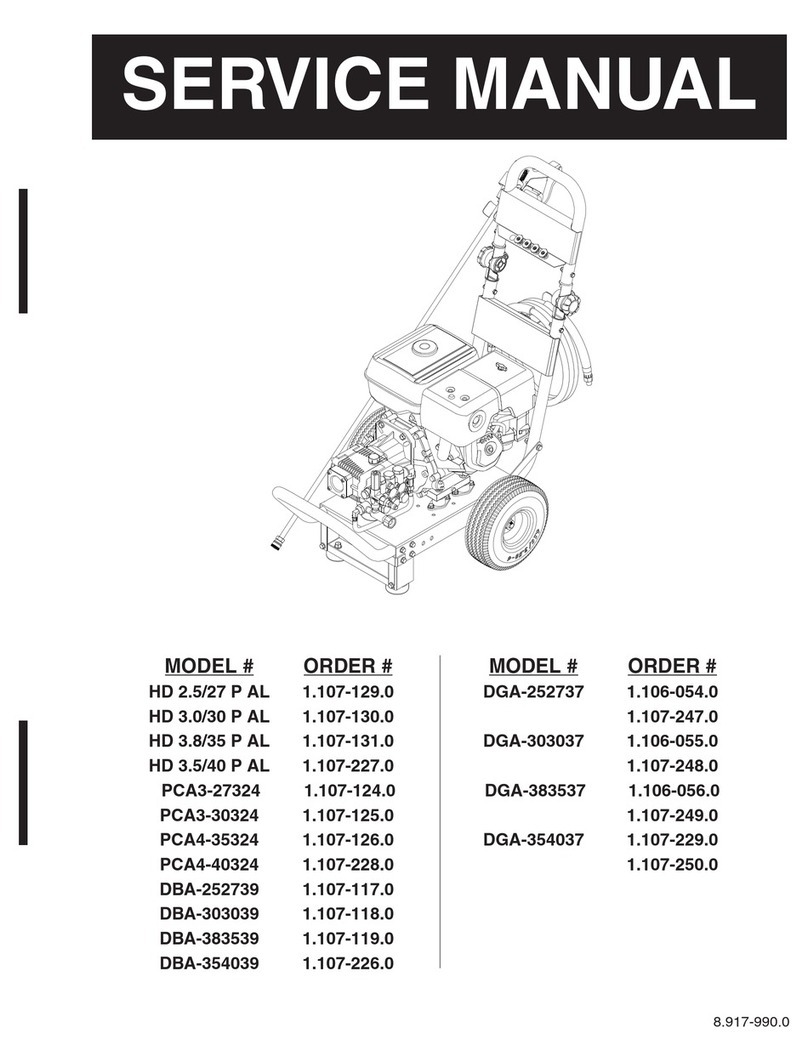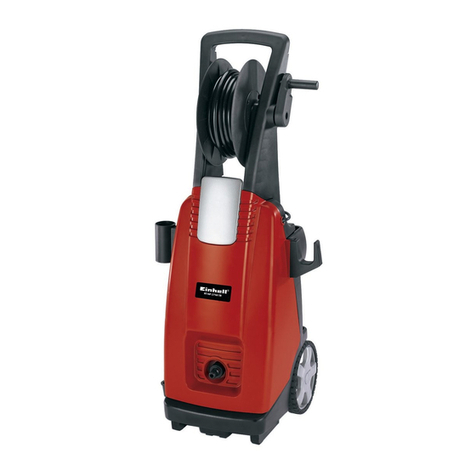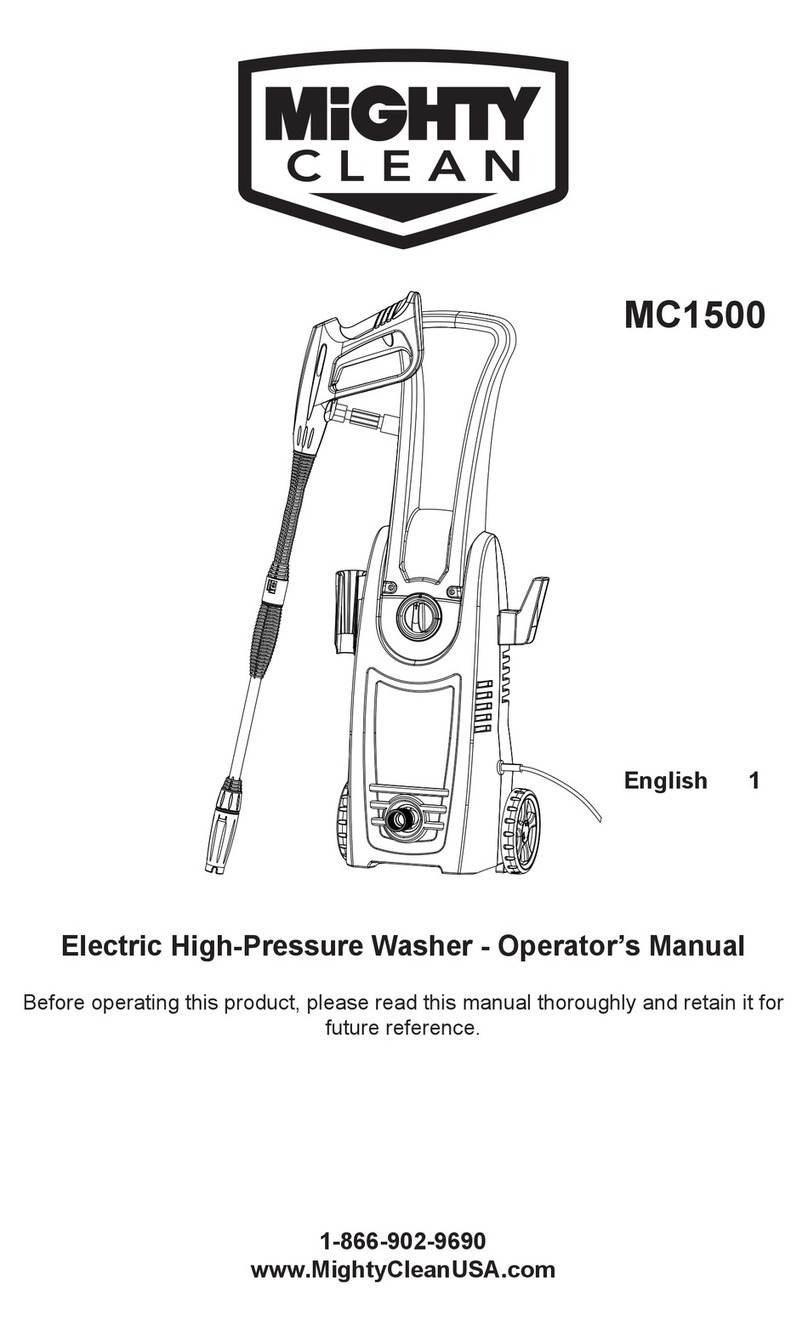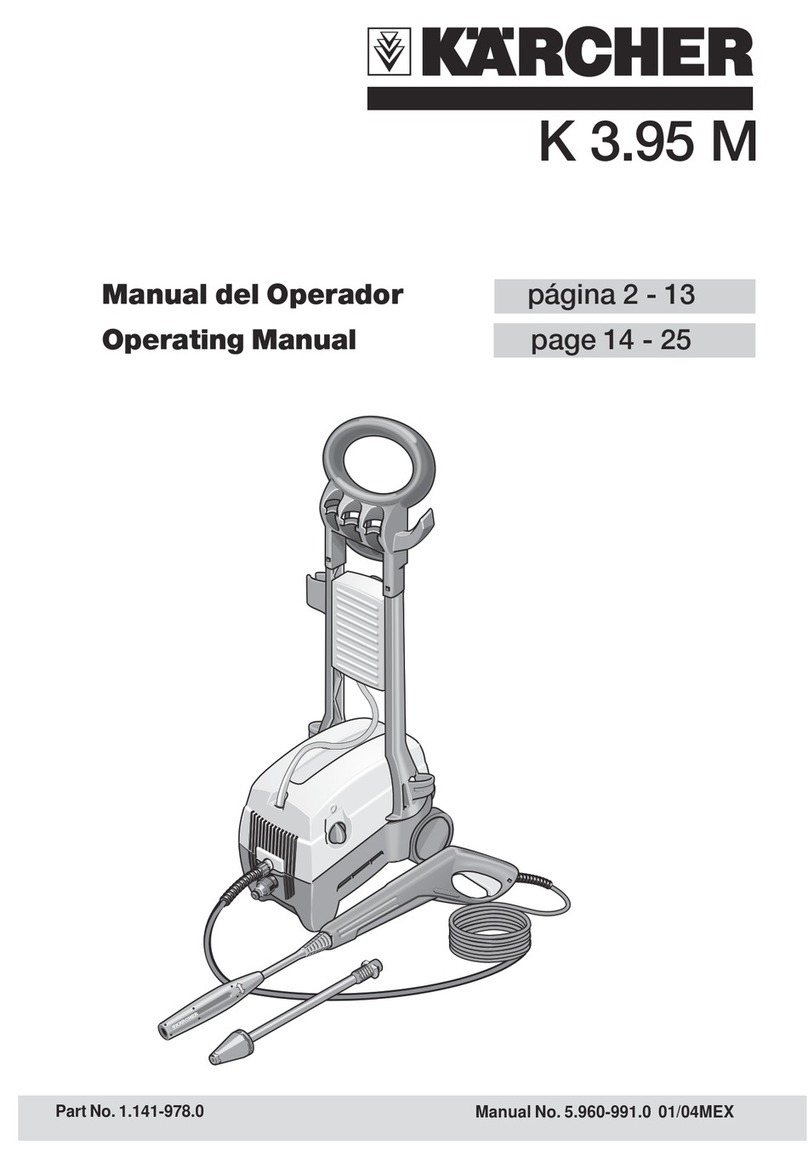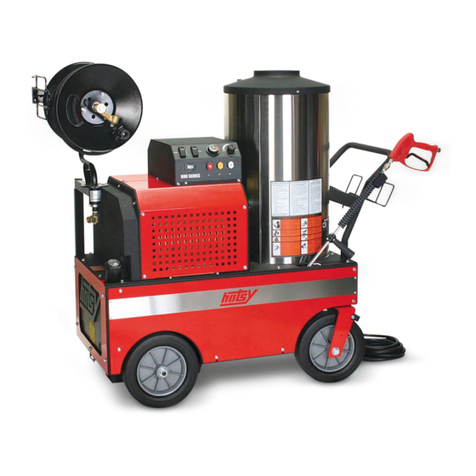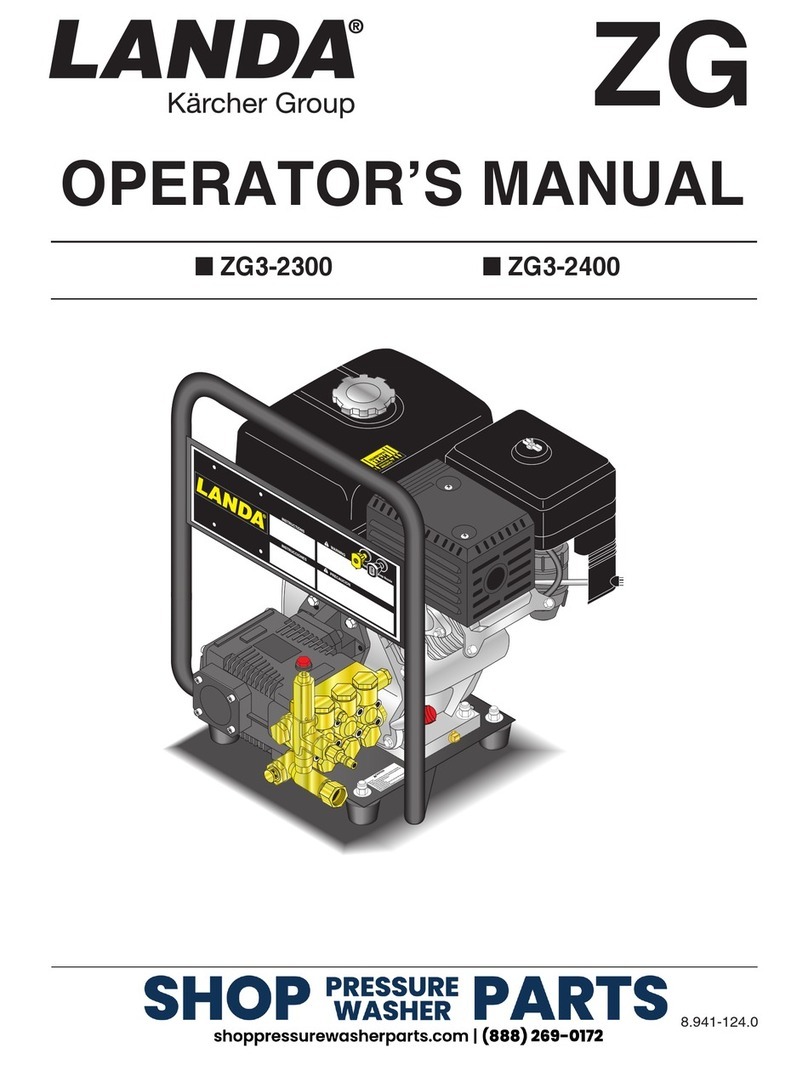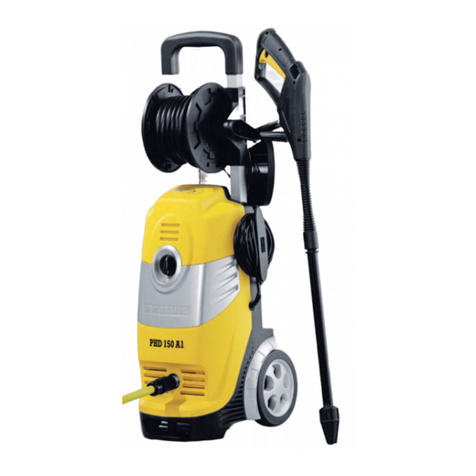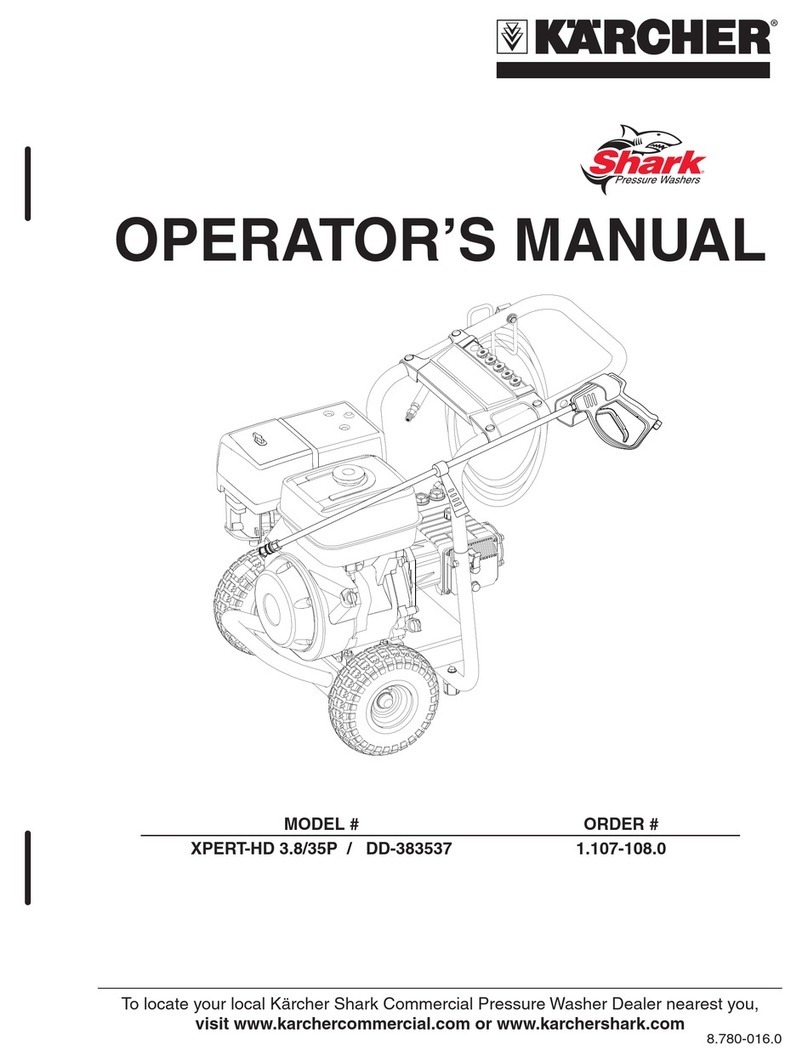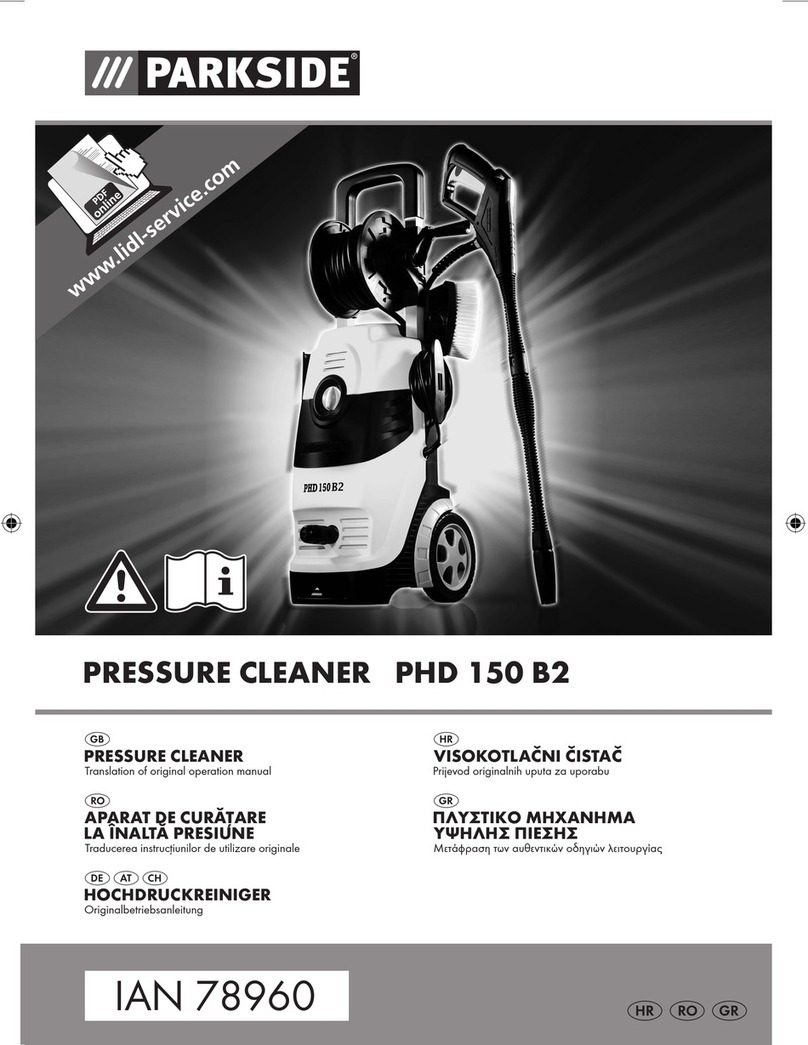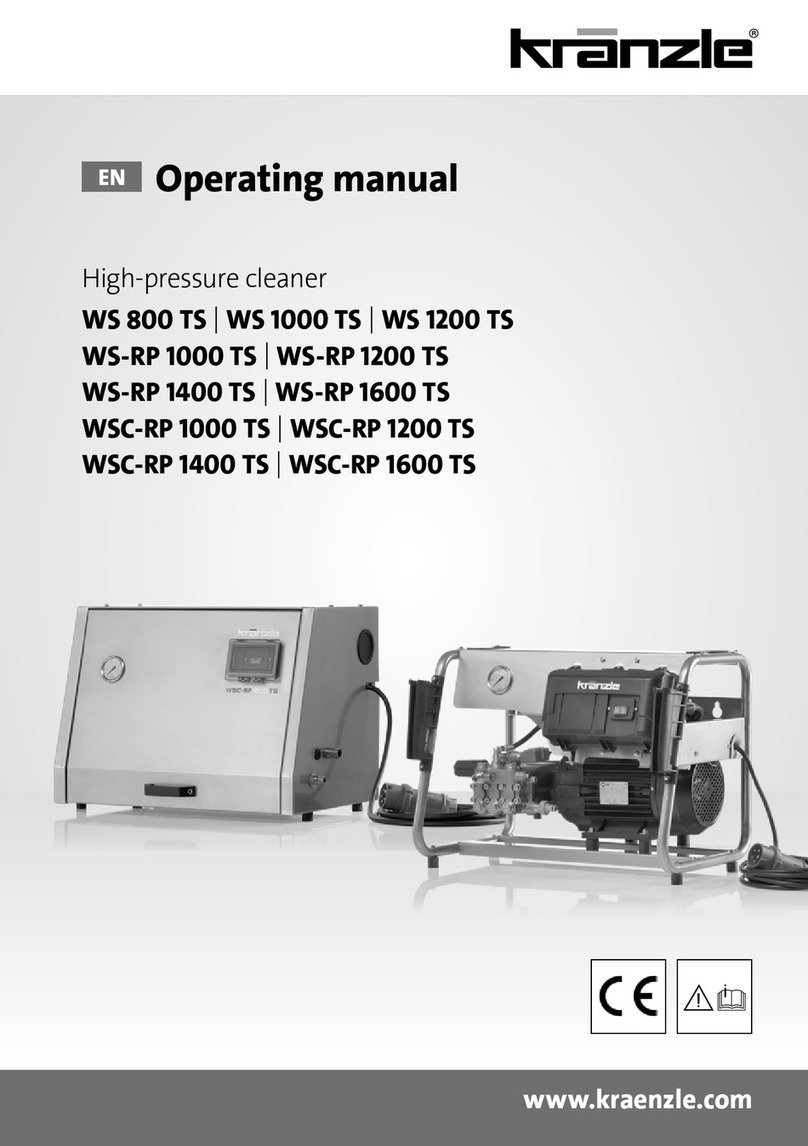Draper 03096 User manual

230V
135/165BAR
PRESSURE
WASHERS
00786, 03095, 03096
These instructions accompanying the product are the original instructions. This document is part of the product, keep
it for the life of the product passing it on to any subsequent holder of the product. Read all these instructions before
assembling, operating or maintaining this product.
This manual has been compiled by Draper Tools describing the purpose for which the product has been designed,
and contains all the necessary information to ensure its correct and safe use. By following all the general safety
instructions contained in this manual, it will ensure both product and operator safety, together with longer life of the
product itself.
All photographs and drawings in this manual are supplied by Draper Tools to help illustrate the operation of the
product.
Whilst every effort has been made to ensure the accuracy of information contained in this manual, the Draper Tools
policy of continuous improvement determines the right to make modifications without prior warning.
Stock No.00786
Stock No.03095 Stock No.03096

2. CONTENTS
2.1 TABLE OF CONTENTS
1.1 INTRODUCTION:
USER MANUAL FOR: 230V 135/165bar Pressure Washers
Stock No’s: 00786, 03095, 03096
Part No’s: PW1600/90D/RED, PW2200/110D/GRN, PW2200/110D/YEL
1.2 REVISIONS:
Date first published August 2021.
As our user manuals are continually updated, users should make
sure that they use the very latest version.
Downloads are available from: http://drapertools.com/manuals
Draper Tools Limited
Hursley Road
Chandler’s Ford
Eastleigh
Hampshire
SO53 1YF
UK
Website: drapertools.com
Product Help Line: +44 (0) 23 8049 4344
General Fax: +44 (0) 23 8026 0784
1.3 UNDERSTANDING THIS MANUALS SAFETY CONTENT:
Warning! – Information that draws attention to the risk of injury or death.
Important – Information that draws attention to the risk of damage to the product or surroundings.
1.4 COPYRIGHT © NOTICE:
Copyright © Draper Tools Limited.
Permission is granted to reproduce this publication for personal and educational use only.
Commercial copying, redistribution, hiring or lending is prohibited.
No part of this publication may be stored in a retrieval system or transmitted in any other form or
means without written permission from Draper Tools Limited.
In all cases this copyright notice must remain intact.
1. TITLE PAGE
– 2 –
1. TITLE PAGE
1.1 INTRODUCTION:......................................................................................................... 2
1.2 REVISIONS:................................................................................................................. 2
1.3 UNDERSTANDING THIS MANUALS SAFETY CONTENT:......................................... 2
1.4 COPYRIGHT © NOTICE:............................................................................................. 2
2. CONTENTS
2.1 TABLE OF CONTENTS ............................................................................................... 3
3. WARRANTY
3.1 WARRANTY................................................................................................................. 4
4. INTRODUCTION
4.1 SCOPE......................................................................................................................... 5
4.2 SPECIFICATION.......................................................................................................... 5
4.3 HANDLING AND STORAGE........................................................................................ 5
5. HEALTH AND SAFETY INFORMATION
5.1 GENERAL SAFETY INSTRUCTIONS FOR POWER TOOL USE ............................... 6
5.2 ADDITIONAL SAFETY INSTRUCTIONS FOR PRESSURE WASHER USE .............. 7
5.3 RESIDUAL RISK.......................................................................................................... 8
5.4 CONNECTION TO THE POWER SUPPLY.................................................................. 8
6. TECHNICAL DESCRIPTION
6.1 IDENTIFICATION......................................................................................................... 9
7. UNPACKING AND CHECKING
7.1 PACKAGING .............................................................................................................. 10
7.2 WHAT’S IN THE BOX ................................................................................................ 10
8. ASSEMBLY
8.1 FITTING THE TRANSPORT HANDLE SECTION ..................................................... 12
8.2 FITTING THE LANCE HOLDER AND CABLE HOOK ............................................... 12
8.3 ATTACHING THE LANCE.......................................................................................... 13
8.4 ATTACHING THE NOZZLES TO THE LANCE .......................................................... 13
8.5 ATTACHING THE INTEGRATED HOSE REEL (03095 AND 03096)......................... 14
8.6 ATTACHING THE HIGH PRESSURE HOSE............................................................. 14
8.7 CONNECTING THE WATER SUPPLY ...................................................................... 15
9. ACCESSORIES
9.1 DETERGENT BOTTLE (07786)................................................................................. 16
9.2 INTEGRATED DETERGENT BOTTLE (03095 & 03096) .......................................... 16
9.3 TURBO NOZZLE ....................................................................................................... 16
9.4 FIXED BRUSH........................................................................................................... 17
9.5 PATION CLEANER ATTACHMENT (03095 ONLY).................................................... 17
9.6 SNOW FOAM PRODUCER ACCESSORY (03096 ONLY)........................................ 17
10. OPERATION
10.1 TOTAL STOP DEVICE ............................................................................................... 18
10.2 SWITCHING ON ........................................................................................................ 18
11. MAINTENANCE AND TROUBLESHOOTING
11.1 TROUBLESHOOTING GUIDE................................................................................... 19
11.2 CLEANING PIN.......................................................................................................... 19
11.3 BLEEDING AIR FROM THE SYSTEM....................................................................... 19
12. DISPOSAL
12.1 DISPOSAL ................................................................................................................. 19
13. EXPLANATION OF SYMBOLS
13.1 EXPLANATION OF SYMBOLS.................................................................................. 20

2. CONTENTS
– 3 –
2.1 TABLE OF CONTENTS
1.1 INTRODUCTION:
USER MANUAL FOR: 230V 135/165bar Pressure Washers
Stock No’s: 00786, 03095, 03096
Part No’s: PW1600/90D/RED, PW2200/110D/GRN, PW2200/110D/YEL
1.2 REVISIONS:
Date first published August 2021.
As our user manuals are continually updated, users should make
sure that they use the very latest version.
Downloads are available from: http://drapertools.com/manuals
Draper Tools Limited
Hursley Road
Chandler’s Ford
Eastleigh
Hampshire
SO53 1YF
UK
Website: drapertools.com
Product Help Line: +44 (0) 23 8049 4344
General Fax: +44 (0) 23 8026 0784
1.3 UNDERSTANDING THIS MANUALS SAFETY CONTENT:
Warning! – Information that draws attention to the risk of injury or death.
Important – Information that draws attention to the risk of damage to the product or surroundings.
1.4 COPYRIGHT © NOTICE:
Copyright © Draper Tools Limited.
Permission is granted to reproduce this publication for personal and educational use only.
Commercial copying, redistribution, hiring or lending is prohibited.
No part of this publication may be stored in a retrieval system or transmitted in any other form or
means without written permission from Draper Tools Limited.
In all cases this copyright notice must remain intact.
1. TITLE PAGE
1.1 INTRODUCTION:......................................................................................................... 2
1.2 REVISIONS:................................................................................................................. 2
1.3 UNDERSTANDING THIS MANUALS SAFETY CONTENT:......................................... 2
1.4 COPYRIGHT © NOTICE:............................................................................................. 2
2. CONTENTS
2.1 TABLE OF CONTENTS ............................................................................................... 3
3. WARRANTY
3.1 WARRANTY................................................................................................................. 4
4. INTRODUCTION
4.1 SCOPE......................................................................................................................... 5
4.2 SPECIFICATION.......................................................................................................... 5
4.3 HANDLING AND STORAGE........................................................................................ 5
5. HEALTH AND SAFETY INFORMATION
5.1 GENERAL SAFETY INSTRUCTIONS FOR POWER TOOL USE ............................... 6
5.2 ADDITIONAL SAFETY INSTRUCTIONS FOR PRESSURE WASHER USE .............. 7
5.3 RESIDUAL RISK.......................................................................................................... 8
5.4 CONNECTION TO THE POWER SUPPLY.................................................................. 8
6. TECHNICAL DESCRIPTION
6.1 IDENTIFICATION......................................................................................................... 9
7. UNPACKING AND CHECKING
7.1 PACKAGING .............................................................................................................. 10
7.2 WHAT’S IN THE BOX ................................................................................................ 10
8. ASSEMBLY
8.1 FITTING THE TRANSPORT HANDLE SECTION ..................................................... 12
8.2 FITTING THE LANCE HOLDER AND CABLE HOOK ............................................... 12
8.3 ATTACHING THE LANCE.......................................................................................... 13
8.4 ATTACHING THE NOZZLES TO THE LANCE .......................................................... 13
8.5 ATTACHING THE INTEGRATED HOSE REEL (03095 AND 03096)......................... 14
8.6 ATTACHING THE HIGH PRESSURE HOSE............................................................. 14
8.7 CONNECTING THE WATER SUPPLY ...................................................................... 15
9. ACCESSORIES
9.1 DETERGENT BOTTLE (07786)................................................................................. 16
9.2 INTEGRATED DETERGENT BOTTLE (03095 & 03096) .......................................... 16
9.3 TURBO NOZZLE ....................................................................................................... 16
9.4 FIXED BRUSH........................................................................................................... 17
9.5 PATION CLEANER ATTACHMENT (03095 ONLY).................................................... 17
9.6 SNOW FOAM PRODUCER ACCESSORY (03096 ONLY)........................................ 17
10. OPERATION
10.1 TOTAL STOP DEVICE ............................................................................................... 18
10.2 SWITCHING ON ........................................................................................................ 18
11. MAINTENANCE AND TROUBLESHOOTING
11.1 TROUBLESHOOTING GUIDE................................................................................... 19
11.2 CLEANING PIN.......................................................................................................... 19
11.3 BLEEDING AIR FROM THE SYSTEM....................................................................... 19
12. DISPOSAL
12.1 DISPOSAL ................................................................................................................. 19
13. EXPLANATION OF SYMBOLS
13.1 EXPLANATION OF SYMBOLS.................................................................................. 20

4. INTRODUCTION
4.1 SCOPE
Compact, lightweight and mobile pressure washer for cleaning vehicles, caravans, motor vans,
driveways, boats and other domestic duties. Any other application is considered misuse.
4.2 SPECIFICATION
Stock No.................................................. 00786 ................................... 03095............................................03096
Part No ............................................
PW1600/90D/RED
.................
PW2200/110D/GRN.................. PW2200/110D/YEL
Rated voltage ................................. 230-240V~50Hz................... 230-240V~50Hz....................230-240V~50Hz
Rated input ............................................ 1600W ..................................2200W ......................................... 2200W
Working pump pressure ...................90bar (1305psi) ................... 110bar (1595psi) ..................110bar (1595psi)
Max. pump pressure........................135bar (1958psi) ..................165bar (2393psi) ..................165bar (2393psi)
Max. flow rate ............................. 7.1L/min (426L/hour) ............8.2L/min (492L/hour) ........ 8.2L/min (492L/hour)
Type of protection .................................... IPX5 ......................................IPX5............................................... IPX5
Max. water feed temperature.................... 50°C..................................... 50°C...............................................50°C
Sound pressure level (LpA)....................77dB(A) ................................77dB(A) .......................................77dB(A)
Sound power level (LWA) .......................93dB(A) ................................94dB(A) .......................................94dB(A)
Uncertainty (K) ..............................3dB(A) ..................................3dB(A) ..........................................3dB(A)
Vibration level†:....................................... 2.5m/s² ................................ 2.5m/s².........................................2.5m/s²
Weight (machine and accessories)
................. 8kg ..................................... 11.5kg .......................................... 11.2kg
4.3 HANDLING AND STORAGE
Note: Every machine is tested in its operating conditions, so it is normal for a few drops of water to
be left inside it.
− This pressure washer and accompanying accessories should not be stored at, or below 0°C.
− Frozen water inside the machine can cause critical damage to pump and other components.
− Care must be taken when handling this product.
• Dropping this power tool could have an effect on its accuracy and could also result in
personal injury. This product is not a toy and must be respected.
− Environmental conditions can have a detrimental effect on this product if neglected.
• Exposure to damp air can gradually corrode components. If the product is unprotected from
dust and debris, components will become clogged.
• If not cleaned and maintained correctly or regularly, the machine will not perform at its best.
3. WARRANTY
– 4 –
3.1 WARRANTY
Draper tools have been carefully tested and inspected before shipment and are guaranteed to be
free from defective materials and workmanship.
Should the tool develop a fault, please return the complete tool to your nearest distributor or
contact:
Draper Tools Limited, Chandler’s Ford, Eastleigh, Hampshire, SO53 1YF. England.
Telephone Sales Desk: +44 (0) 8049 4333 or Product Help Line +44 (0) 23 8049 4344.
A proof of purchase must be provided with the tool.
If upon inspection it is found that the fault occurring is due to defective materials or workmanship,
repairs will be carried out free of charge. This warranty period covering labour is 12 months from
the date of purchase except where tools are hired out when the warranty period is 90 days from
the date of purchase. The warranty is extended to 24 months for parts only. This warranty does not
apply to any consumable parts, any type of battery or normal wear and tear, nor does it cover any
damage caused by misuse, careless or unsafe handling, alterations, accidents, or repairs
attempted or made by any personnel other than the authorised Draper warranty repair agent.
Note: If the tool is found not to be within the terms of warranty, repairs and carriage charges will
be quoted and made accordingly.
This warranty applies in lieu of any other warranty expressed or implied and variations of its terms
are not authorised.
Your Draper warranty is not effective unless you can produce upon request a dated receipt or
invoice to verify your proof of purchase within the warranty period.
Please note that this warranty is an additional benefit and does not affect your statutory rights.
Draper Tools Limited.

4. INTRODUCTION
4.1 SCOPE
Compact, lightweight and mobile pressure washer for cleaning vehicles, caravans, motor vans,
driveways, boats and other domestic duties. Any other application is considered misuse.
4.2 SPECIFICATION
Stock No.................................................. 00786 ................................... 03095............................................03096
Part No ............................................
PW1600/90D/RED
.................
PW2200/110D/GRN.................. PW2200/110D/YEL
Rated voltage ................................. 230-240V~50Hz................... 230-240V~50Hz....................230-240V~50Hz
Rated input ............................................ 1600W ..................................2200W ......................................... 2200W
Working pump pressure ...................90bar (1305psi) ................... 110bar (1595psi) ..................110bar (1595psi)
Max. pump pressure........................135bar (1958psi) ..................165bar (2393psi) ..................165bar (2393psi)
Max. flow rate ............................. 7.1L/min (426L/hour) ............8.2L/min (492L/hour) ........ 8.2L/min (492L/hour)
Type of protection .................................... IPX5 ......................................IPX5............................................... IPX5
Max. water feed temperature.................... 50°C..................................... 50°C...............................................50°C
Sound pressure level (LpA)....................77dB(A) ................................77dB(A) .......................................77dB(A)
Sound power level (LWA) .......................93dB(A) ................................94dB(A) .......................................94dB(A)
Uncertainty (K) ..............................3dB(A) ..................................3dB(A) ..........................................3dB(A)
Vibration level†:....................................... 2.5m/s² ................................ 2.5m/s².........................................2.5m/s²
Weight (machine and accessories)
................. 8kg ..................................... 11.5kg .......................................... 11.2kg
4.3 HANDLING AND STORAGE
Note: Every machine is tested in its operating conditions, so it is normal for a few drops of water to
be left inside it.
− This pressure washer and accompanying accessories should not be stored at, or below 0°C.
− Frozen water inside the machine can cause critical damage to pump and other components.
− Care must be taken when handling this product.
• Dropping this power tool could have an effect on its accuracy and could also result in
personal injury. This product is not a toy and must be respected.
− Environmental conditions can have a detrimental effect on this product if neglected.
• Exposure to damp air can gradually corrode components. If the product is unprotected from
dust and debris, components will become clogged.
• If not cleaned and maintained correctly or regularly, the machine will not perform at its best.
– 5 –
3.1 WARRANTY
Draper tools have been carefully tested and inspected before shipment and are guaranteed to be
free from defective materials and workmanship.
Should the tool develop a fault, please return the complete tool to your nearest distributor or
contact:
Draper Tools Limited, Chandler’s Ford, Eastleigh, Hampshire, SO53 1YF. England.
Telephone Sales Desk: +44 (0) 8049 4333 or Product Help Line +44 (0) 23 8049 4344.
A proof of purchase must be provided with the tool.
If upon inspection it is found that the fault occurring is due to defective materials or workmanship,
repairs will be carried out free of charge. This warranty period covering labour is 12 months from
the date of purchase except where tools are hired out when the warranty period is 90 days from
the date of purchase. The warranty is extended to 24 months for parts only. This warranty does not
apply to any consumable parts, any type of battery or normal wear and tear, nor does it cover any
damage caused by misuse, careless or unsafe handling, alterations, accidents, or repairs
attempted or made by any personnel other than the authorised Draper warranty repair agent.
Note: If the tool is found not to be within the terms of warranty, repairs and carriage charges will
be quoted and made accordingly.
This warranty applies in lieu of any other warranty expressed or implied and variations of its terms
are not authorised.
Your Draper warranty is not effective unless you can produce upon request a dated receipt or
invoice to verify your proof of purchase within the warranty period.
Please note that this warranty is an additional benefit and does not affect your statutory rights.
Draper Tools Limited.

5. HEALTH AND SAFETY INFORMATION
Wait for the machine to stop. Unless the machine is fitted with a safety brake, some parts may
continue to move due to momentum. Wait for all parts to stop, then unplug it from the power supply
before making any adjustments, carrying out maintenance operations or just finishing using the
tool.
Remove and check setting tools. Some machinery requires the use of additional tools or keys to
set, load or adjust the power tool. Before starting the power tool always check to make certain they
have been removed and are safely away from the machine.
Prevent unintentional starting. Before plugging any machine in to the power supply, make sure
the switch is in the OFF position. If the machine is portable, do not hold the machine near the
switch and take care when putting the machine down, that nothing can operate the switch.
Carefully select an extension lead. Some machines are not suitable for use with extension
leads. If the tool is designed for use outdoors, use an extension lead also suitable for that
environment. When using an extended lead, select one capable of handling the current (amps)
drawn by the machine in use. Fully extend the lead regardless of the distance between the power
supply and the tool. Excess current (amps) and a coiled extension lead will both cause the cable to
heat up and can result in fire.
Concentrate and stay alert. Distractions are likely to cause an accident. Never operate a power
tool if you are under the influence of drugs (prescription or otherwise), including alcohol or if you
are feeling tired. Being disorientated will result in an accident.
Have this tool repaired by a qualified person. This tool is designed to conform to the relevant
international and local standards and as such should be maintained and repaired by someone
qualified, using only original parts supplied by the manufacturer. This will ensure the tool remains
safe to use.
5.2 ADDITIONAL SAFETY INSTRUCTIONS FOR PRESSURE WASHER USE
Warning!
− This appliance is for outdoor use only.
− Always disconnect the electricity and water supplies on completion of every job.
− Never use the appliance if the electrical cable or important parts of the appliance are damaged,
e.g. safety devices, high pressure hose, gun, etc.
− This appliance has been designed for use with a neutral shampoo based on biodegradable
anionic surface active detergents. The use of other detergents or chemicals may put the
appliance’s safety at risk.
− Never use the appliance with people in the vicinity, unless they are wearing protective clothing.
− Do not direct the nozzle toward mechanical parts containing lubricant grease, as the grease
will dissolve and spread over the surrounding ground. Vehicle tyres/tyre valves may only be
cleaned from a minimum distance of 30cm, otherwise the vehicle tyre/tyre valve could be
damaged by the high-pressure jet. The first indication of this is a discolouration of the tyre.
Damaged vehicle tyres/tyre valves can be deadly dangerous.
− High pressure jets may be dangerous if improperly used. Jets must never be pointed at people,
animals, live electrical equipment or the appliance itself.
− The hoses, accessories and high pressure couplings are important for the appliance’s safety.
Use only hoses, accessories and couplings recommended (it is extremely important to protect
these components against damage by avoiding their improper use and protecting them against
bending, knocks and scratches).
− The gun is fitted with a safety catch. Whenever use of the machine is interrupted it is important
to operate the safety catch to prevent accidental activation of the jet.
− Never point the jet at yourself or others to clean clothing or footwear.
− Never allow children or untrained people to use the appliance.
5. HEALTH AND SAFETY INFORMATION
5.1 GENERAL SAFETY INSTRUCTIONS FOR POWER TOOL USE
When using any type of power tool there are steps that should be taken to make sure that you, as
the user, remain safe.
Common sense and a respect for the tool will help reduce the risk of injury.
Read the instruction manual fully. Do not attempt any operation until you have read and
understood this manual.
Most important you must know how to safely start and stop this machine, especially in an
emergency.
Keep the work area tidy and clean. Attempting to clear clutter from around the machine during
use will reduce your concentration. Mess on the floor creates a trip hazard. Any liquid spilt on the
floor could result in you slipping.
Find a suitable location. If the machine is bench mounted, the location should provide good
natural light or artificial lighting as a replacement. Avoid damp and dust locations as it will have a
negative effect on the machine’s performance. If the machine is portable do not expose the tool to
rain. In all cases do not operate power tools near any flammable materials.
Keep bystanders away. Children, onlookers and passers by must be restricted from entering the
work area for their own protection. The barrier must extend a suitable distance from the tool user.
Unplug and house all power tools that are not in use. A power tool should never be left unattended
while connected to the power supply. They must be housed in a suitable location, away locked up
and from children. This includes battery chargers.
Do not overload or misuse the tool. All tools are designed for a purpose and are limited to what
they are capable of doing. Do not attempt to use a power tool (or adapt it in any way) for an
application it is not designed for. Select a tool appropriate for the size of the job. Overloading a tool
will result in tool failure and user injury. This covers the use of accessories.
Dress properly. Loose clothing, long hair and jewellery are all dangerous because they can
become entangled in moving machinery. This can also result in parts of body being pulled into the
machine. Clothing should be close fitted, with any long hair tired back and jewellery and neck ties
removed. Footwear must be fully enclosed and have a non-slip sole.
Wear personal protective equipment (PPE). Dust, noise, vibration and swarf can all be
dangerous if not suitably protected against. If the work involving the power tool creates dust or
fumes wear a dust mask. Vibration to the hand, caused by operating some tools for longer periods
must be protected against. Wear vibration reducing gloves and allow long breaks between uses.
Protect against dust and swarf by wearing approved safety goggles or a face shield. These are
some of the more common hazards and preventions, however, always find out what hazards are
associated with the machine/work process and wear the most suitable protective equipment
available.
Do not breathe contaminated air. If the work creates dust or fumes connect the machine (if
possible) to an extraction system either locally or remotely. Working outdoors can also help if
possible.
Move the machine as instructed. If the machine is hand held, do not carry it by the power supply
cable. If the product is heavy, employ a second or third person to help move it safely or use a
mechanical device. Always refer to the instructions for the correct method.
Do not overreach. Extending your body too far can result in a loss of balance and you falling. This
could be from a height or onto a machine and will result in injury.
Maintain your tools correctly. A well maintained tool will do the job safely. Replace any damaged
or missing parts immediately with original parts from the manufacturer. As applicable, keep blades
sharp, moving parts clean, oiled or greased, handles clean, and emergency devices working.
– 6 –

5. HEALTH AND SAFETY INFORMATION
Wait for the machine to stop. Unless the machine is fitted with a safety brake, some parts may
continue to move due to momentum. Wait for all parts to stop, then unplug it from the power supply
before making any adjustments, carrying out maintenance operations or just finishing using the
tool.
Remove and check setting tools. Some machinery requires the use of additional tools or keys to
set, load or adjust the power tool. Before starting the power tool always check to make certain they
have been removed and are safely away from the machine.
Prevent unintentional starting. Before plugging any machine in to the power supply, make sure
the switch is in the OFF position. If the machine is portable, do not hold the machine near the
switch and take care when putting the machine down, that nothing can operate the switch.
Carefully select an extension lead. Some machines are not suitable for use with extension
leads. If the tool is designed for use outdoors, use an extension lead also suitable for that
environment. When using an extended lead, select one capable of handling the current (amps)
drawn by the machine in use. Fully extend the lead regardless of the distance between the power
supply and the tool. Excess current (amps) and a coiled extension lead will both cause the cable to
heat up and can result in fire.
Concentrate and stay alert. Distractions are likely to cause an accident. Never operate a power
tool if you are under the influence of drugs (prescription or otherwise), including alcohol or if you
are feeling tired. Being disorientated will result in an accident.
Have this tool repaired by a qualified person. This tool is designed to conform to the relevant
international and local standards and as such should be maintained and repaired by someone
qualified, using only original parts supplied by the manufacturer. This will ensure the tool remains
safe to use.
5.2 ADDITIONAL SAFETY INSTRUCTIONS FOR PRESSURE WASHER USE
Warning!
− This appliance is for outdoor use only.
− Always disconnect the electricity and water supplies on completion of every job.
− Never use the appliance if the electrical cable or important parts of the appliance are damaged,
e.g. safety devices, high pressure hose, gun, etc.
− This appliance has been designed for use with a neutral shampoo based on biodegradable
anionic surface active detergents. The use of other detergents or chemicals may put the
appliance’s safety at risk.
− Never use the appliance with people in the vicinity, unless they are wearing protective clothing.
− Do not direct the nozzle toward mechanical parts containing lubricant grease, as the grease
will dissolve and spread over the surrounding ground. Vehicle tyres/tyre valves may only be
cleaned from a minimum distance of 30cm, otherwise the vehicle tyre/tyre valve could be
damaged by the high-pressure jet. The first indication of this is a discolouration of the tyre.
Damaged vehicle tyres/tyre valves can be deadly dangerous.
− High pressure jets may be dangerous if improperly used. Jets must never be pointed at people,
animals, live electrical equipment or the appliance itself.
− The hoses, accessories and high pressure couplings are important for the appliance’s safety.
Use only hoses, accessories and couplings recommended (it is extremely important to protect
these components against damage by avoiding their improper use and protecting them against
bending, knocks and scratches).
− The gun is fitted with a safety catch. Whenever use of the machine is interrupted it is important
to operate the safety catch to prevent accidental activation of the jet.
− Never point the jet at yourself or others to clean clothing or footwear.
− Never allow children or untrained people to use the appliance.
– 7 –
5. HEALTH AND SAFETY INFORMATION
5.1 GENERAL SAFETY INSTRUCTIONS FOR POWER TOOL USE
When using any type of power tool there are steps that should be taken to make sure that you, as
the user, remain safe.
Common sense and a respect for the tool will help reduce the risk of injury.
Read the instruction manual fully. Do not attempt any operation until you have read and
understood this manual.
Most important you must know how to safely start and stop this machine, especially in an
emergency.
Keep the work area tidy and clean. Attempting to clear clutter from around the machine during
use will reduce your concentration. Mess on the floor creates a trip hazard. Any liquid spilt on the
floor could result in you slipping.
Find a suitable location. If the machine is bench mounted, the location should provide good
natural light or artificial lighting as a replacement. Avoid damp and dust locations as it will have a
negative effect on the machine’s performance. If the machine is portable do not expose the tool to
rain. In all cases do not operate power tools near any flammable materials.
Keep bystanders away. Children, onlookers and passers by must be restricted from entering the
work area for their own protection. The barrier must extend a suitable distance from the tool user.
Unplug and house all power tools that are not in use. A power tool should never be left unattended
while connected to the power supply. They must be housed in a suitable location, away locked up
and from children. This includes battery chargers.
Do not overload or misuse the tool. All tools are designed for a purpose and are limited to what
they are capable of doing. Do not attempt to use a power tool (or adapt it in any way) for an
application it is not designed for. Select a tool appropriate for the size of the job. Overloading a tool
will result in tool failure and user injury. This covers the use of accessories.
Dress properly. Loose clothing, long hair and jewellery are all dangerous because they can
become entangled in moving machinery. This can also result in parts of body being pulled into the
machine. Clothing should be close fitted, with any long hair tired back and jewellery and neck ties
removed. Footwear must be fully enclosed and have a non-slip sole.
Wear personal protective equipment (PPE). Dust, noise, vibration and swarf can all be
dangerous if not suitably protected against. If the work involving the power tool creates dust or
fumes wear a dust mask. Vibration to the hand, caused by operating some tools for longer periods
must be protected against. Wear vibration reducing gloves and allow long breaks between uses.
Protect against dust and swarf by wearing approved safety goggles or a face shield. These are
some of the more common hazards and preventions, however, always find out what hazards are
associated with the machine/work process and wear the most suitable protective equipment
available.
Do not breathe contaminated air. If the work creates dust or fumes connect the machine (if
possible) to an extraction system either locally or remotely. Working outdoors can also help if
possible.
Move the machine as instructed. If the machine is hand held, do not carry it by the power supply
cable. If the product is heavy, employ a second or third person to help move it safely or use a
mechanical device. Always refer to the instructions for the correct method.
Do not overreach. Extending your body too far can result in a loss of balance and you falling. This
could be from a height or onto a machine and will result in injury.
Maintain your tools correctly. A well maintained tool will do the job safely. Replace any damaged
or missing parts immediately with original parts from the manufacturer. As applicable, keep blades
sharp, moving parts clean, oiled or greased, handles clean, and emergency devices working.

6. TECHNICAL DESCRIPTION
6.1 IDENTIFICATION
(1) Spray release trigger.
(2) Hose release button.
(3) Transport handle.
(4) Lance holder.
(5) Power supply ON/OFF switch.
(6) Water inlet connection adaptor.
(7) Spray nozzle.
(8) Nozzle release button.
5. HEALTH AND SAFETY INFORMATION
− The safety button on the gun is not there to lock the lever during operation, but to prevent its
accidental operation.
− Appliances equipped with Total Stop System: these appliances should not be left in standby for
more than 5 minutes.
− Switch the appliance off completely (master switch ON/OFF) whenever it is left unattended.
− Take care not to damage the electric cable. Have a damaged power cord replaced immediately
by an authorized service point or an electrical specialist.
− The high pressure hose is designed and produced to withstand high pressures. To avoid
damage, it must be handled with special care. Misuse may lead to premature breakages or
damage and cause the loss of warranty cover.
− Never start the high-pressure cleaner without first completely unwinding the high-pressure
hose.
− When winding and unwinding the hose take care not to cause the high pressure cleaner to
overturn.
− Before unwinding or winding the hose, switch the machine off and release the pressure in the
hose itself (switching off).
5.3 RESIDUAL RISK
Important: Although the safety instructions and operating manuals for our tools contain extensive
instructions of safe working with power tools, every power tool involves a certain residual risk
which can not be completely excluded by safety mechanisms. Power tools must therefore always
be operated with caution!
5.4 CONNECTION TO THE POWER SUPPLY
Caution: Risk of electric shock. Do not open.
This appliance is supplied with an approved plug and cable for your safety. The value of the fuse
fitted is marked on the pin face of the plug. Should the fuse need replacing, ensure the substitute
is of the correct rating, approved to BS1362 and ASTA or BS Kite marked.
ASTA
BSI
The fuse cover is removable with a small plain slot screwdriver. Ensure the fuse cover is replaced
before attempting to connect the plug to an electrical outlet. If the cover is missing, a replacement
must be obtained or the plug replaced with a suitable type.
If a replacement plug is to be fitted this must be carried out by a qualified electrician.
The damaged or incomplete plug, when cut from the cable should be disabled to prevent
connection to a live electrical outlet.
This appliance is Class II† and is designed for connection to a power supply matching that detailed
on the rating label and compatible with the plug fitted.
If an extension lead is required, use an approved and compatible lead rated for this appliance.
Follow all the instructions supplied with the extension lead.
†Double insulated
: This product requires no earth connection as supplementary insulation is
applied to the basic insulation to protect against electric shock in the event of failure of the basic
insulation.
IMPORTANT
If using an extension lead, follow the instructions that came with your lead regarding
maximum load while cable is wound. If in doubt, ensure that the entire cable is unwound.
Using a coiled extension lead will generate heat which could melt the lead and cause a fire.
– 8 –

6. TECHNICAL DESCRIPTION
– 9 –
6.1 IDENTIFICATION
(1) Spray release trigger.
(2) Hose release button.
(3) Transport handle.
(4) Lance holder.
(5) Power supply ON/OFF switch.
(6) Water inlet connection adaptor.
(7) Spray nozzle.
(8) Nozzle release button.
(9) Lance section.
(10) High pressure hose.
(11) Cable hook.
(12) Trigger assembly section.
(13) High pressure hose outlet connection.
(14) Transport wheels.
(15) Integral hose reel (03095 and 03096 only).
(16)
Integral detergent bottle (03095 and 03096 only)
.
5. HEALTH AND SAFETY INFORMATION
− The safety button on the gun is not there to lock the lever during operation, but to prevent its
accidental operation.
− Appliances equipped with Total Stop System: these appliances should not be left in standby for
more than 5 minutes.
− Switch the appliance off completely (master switch ON/OFF) whenever it is left unattended.
− Take care not to damage the electric cable. Have a damaged power cord replaced immediately
by an authorized service point or an electrical specialist.
− The high pressure hose is designed and produced to withstand high pressures. To avoid
damage, it must be handled with special care. Misuse may lead to premature breakages or
damage and cause the loss of warranty cover.
− Never start the high-pressure cleaner without first completely unwinding the high-pressure
hose.
− When winding and unwinding the hose take care not to cause the high pressure cleaner to
overturn.
− Before unwinding or winding the hose, switch the machine off and release the pressure in the
hose itself (switching off).
5.3 RESIDUAL RISK
Important: Although the safety instructions and operating manuals for our tools contain extensive
instructions of safe working with power tools, every power tool involves a certain residual risk
which can not be completely excluded by safety mechanisms. Power tools must therefore always
be operated with caution!
5.4 CONNECTION TO THE POWER SUPPLY
Caution: Risk of electric shock. Do not open.
This appliance is supplied with an approved plug and cable for your safety. The value of the fuse
fitted is marked on the pin face of the plug. Should the fuse need replacing, ensure the substitute
is of the correct rating, approved to BS1362 and ASTA or BS Kite marked.
ASTA
BSI
The fuse cover is removable with a small plain slot screwdriver. Ensure the fuse cover is replaced
before attempting to connect the plug to an electrical outlet. If the cover is missing, a replacement
must be obtained or the plug replaced with a suitable type.
If a replacement plug is to be fitted this must be carried out by a qualified electrician.
The damaged or incomplete plug, when cut from the cable should be disabled to prevent
connection to a live electrical outlet.
This appliance is Class II† and is designed for connection to a power supply matching that detailed
on the rating label and compatible with the plug fitted.
If an extension lead is required, use an approved and compatible lead rated for this appliance.
Follow all the instructions supplied with the extension lead.
†Double insulated
: This product requires no earth connection as supplementary insulation is
applied to the basic insulation to protect against electric shock in the event of failure of the basic
insulation.
IMPORTANT
If using an extension lead, follow the instructions that came with your lead regarding
maximum load while cable is wound. If in doubt, ensure that the entire cable is unwound.
Using a coiled extension lead will generate heat which could melt the lead and cause a fire.
(1)
(2)
(3)
(4)
(9)
(8)
(14)
(5)
(7)
(13)
(12)
(10)
(15)
Stock No.03095
Stock No.00786
Stock No.03095 &
03096
Stock No.03095 &
03096 only
Stock No.00786
(6)
(6)
(13)
(16)
(11)

– 10 –
7. UNPACKING AND CHECKING
7.1 PACKAGING
Carefully remove the product from the packaging and examine it for any sign of damage that may
have happened during shipping. Lay the contents out and check them against the parts shown
below. If any part is damaged or missing, please contact the Draper Help Line (the telephone
number appears on the Title page) and do not attempt to use the product.
The packaging material should be retained at least during the warranty period, in case the
machine needs to be returned for repair.
Warning!
− Some of the packaging materials used may be harmful to children. Do not leave any of these
materials in the reach of children.
− If any of the packaging is to be thrown away, make sure they are disposed of correctly,
according to local regulations.
7.2 WHAT’S IN THE BOX
As well as the main product, there are several parts not fitted or attached to it.
Note: For details of our full range of accessories and consumables, please visit drapertools.com
(3) Transport handle.
(4) Lance holder.
(6) Water inlet connection
adaptor.
(7) Spray nozzle.
(9) Lance.
(10) High pressure hose.
(11) Cable hook.
(12) Trigger assembly
section.
(16) Detergent bottle
(00786).
(18) Fixed brush.
(19) Turbo nozzle.
(20) Nozzle cleaning pin.
(21) Screws × 2 (00786).
Stock No.00786
(10) (21)
(11)
(9)
(18)
(19)
(7)
(3)
(4)
(16)
(20)
(6)
(12)
7. UNPACKING AND CHECKING

– 11 –
7. UNPACKING AND CHECKING
7.1 PACKAGING
Carefully remove the product from the packaging and examine it for any sign of damage that may
have happened during shipping. Lay the contents out and check them against the parts shown
below. If any part is damaged or missing, please contact the Draper Help Line (the telephone
number appears on the Title page) and do not attempt to use the product.
The packaging material should be retained at least during the warranty period, in case the
machine needs to be returned for repair.
Warning!
− Some of the packaging materials used may be harmful to children. Do not leave any of these
materials in the reach of children.
− If any of the packaging is to be thrown away, make sure they are disposed of correctly,
according to local regulations.
7.2 WHAT’S IN THE BOX
As well as the main product, there are several parts not fitted or attached to it.
Note: For details of our full range of accessories and consumables, please visit drapertools.com
(3) Transport handle.
(4) Lance holder.
(6) Water inlet connection
adaptor.
(7) Spray nozzle.
(9) Lance.
(10) High pressure hose.
(11) Cable hook.
(12) Trigger assembly
section.
(16) Detergent bottle
(00786).
(18) Fixed brush.
(19) Turbo nozzle.
(20) Nozzle cleaning pin.
(21) Screws × 2 (00786).
7. UNPACKING AND CHECKING
(3) Transport handle.
(4) Lance holder.
(6) Water inlet connection
adaptor.
(7) Spray nozzle.
(9) Lance.
(10) High pressure hose.
(12) Trigger assembly
section.
(15) Hose reel
(03095 and 03096).
(17) Detergent bottle
(03095 and 03096).
(18) Fixed brush.
(19) Turbo nozzle.
(20) Nozzle cleaning pin.
(22) Screws × 4
(03095 and 03096).
(23) Patio cleaning
attachment
(03095 only).
(24) Snow foam producer
(03096 only).
Stock No.03095
(12) (9)
(15)
(19)
(3)
(4)
(20)
(22)
(6)
(10)
(17)
(7)
(18)
(11)
Stock No.03095 only Stock No.03096 only
(23)
Stock No.03096
(12) (9)
(15)
(19)
(3)
(4)
(20)
(22)
(6)
(10)
(17)
(7)
(18)
(11)
(24)

– 12 –
8. ASSEMBLY
8.3 ATTACHING THE LANCE –
FIGS.5 – 6
− Connect the lance (9) to the trigger assembly
section (12) by pushing in the bayonet fitting
and turning anti-clockwise 45° to lock in place.
8.4 ATTACHING THE NOZZLES TO
THE LANCE – FIGS.7 – 8
− To connect either the spray nozzle (7) or turbo
nozzle (19) to the lance (9), push-fit the nozzle
into the end of the lance until it clicks into place.
To remove, press the release button (9.1) on
the lance to disconnect.
8. ASSEMBLY
8.1 FITTING THE TRANSPORT
HANDLE SECTION – FIGS.1 – 2
− Slide the transport handle section (3) over the
mounting points (A) at the top of the main body
of the pressure washer.
− From the back of the pressure washer, locate
the 2 supplied screws (21) with the holes in the
mounting points and screw in to secure the
handle section in place
8.2 FITTING THE LANCE HOLDER
AND CABLE HOOK – FIGS.3 – 4
Attach the lance holder (4) and cable hook (11) at
the location points, then slide down over the fittings
to secure.
1
2
FIG.
FIG.
3
4
FIG.
FIG.
(11)
(3)
Stock No.00786 shown
Stock No.00786 shown
(21)
(A)
(A)
(4)

– 13 –
8. ASSEMBLY
8.3 ATTACHING THE LANCE –
FIGS.5 – 6
− Connect the lance (9) to the trigger assembly
section (12) by pushing in the bayonet fitting
and turning anti-clockwise 45° to lock in place.
8.4 ATTACHING THE NOZZLES TO
THE LANCE – FIGS.7 – 8
− To connect either the spray nozzle (7) or turbo
nozzle (19) to the lance (9), push-fit the nozzle
into the end of the lance until it clicks into place.
To remove, press the release button (9.1) on
the lance to disconnect. 5
6
FIG.
FIG.
7
8
FIG.
FIG.
(12)
(9)
(9.1)
(19)
(7)
8. ASSEMBLY
1
2
3
4
Stock No.00786 shown

– 14 –
8. ASSEMBLY
8.7 CONNECTING THE WATER
SUPPLY – FIGS.13 – 14
− Screw the supplied water inlet adaptor (6) to
the water inlet connection (6.1) taking care not
to cross the threads.
− To connect the pressure washer to the water
supply, a push fit hose connector will be
required (FIG.14). Ensure the connector is
correctly fitted to the hose and that a ‘click’ is
heard when attaching to the machine.
Note: The supply must be between 1.5bar and
6.0bar and 7 litres/min.
Note: Max. water temp: 40°C.
Note: Always observe local bye-laws and
regulations.
8. ASSEMBLY
8.5 ATTACHING THE INTEGRATED
HOSE REEL (03095 and 03096
only) – FIGS.9 – 10
− Position the hose reel section (15) within the
cut out recessed area of the handle section
(3).
− Locate the 4 supplied screws (22) with the
mounting point holes (B) and screw in to
secure the hose reel to the handle.
8.6 ATTACHING THE HIGH
PRESSURE HOSE
– FIGS.11 – 12
− To connect the high pressure hose (10) to the
trigger assembly (12), push-fit the hose
connector into the inlet on the assembly.
• Disconnection of the hose is achieved by
pressing the hose release button (2).
− Insert the other end of the hose (10) into the
high pressure outlet (13) and screw the
shrouded end of the hose onto the threaded
outer section of the pressure outlet, taking care
not to cross the threads.
11
9
12
FIG.
FIG.
FIG.
10FIG.
(2)
(22)
(10) (13)
(12)
(10)
(3)
Stock No.98676
Stock No.98677
(13)
(10)
B
B
B
B

– 15 –
8. ASSEMBLY
8.7 CONNECTING THE WATER
SUPPLY – FIGS.13 – 14
− Screw the supplied water inlet adaptor (6) to
the water inlet connection (6.1) taking care not
to cross the threads.
− To connect the pressure washer to the water
supply, a push fit hose connector will be
required (FIG.14). Ensure the connector is
correctly fitted to the hose and that a ‘click’ is
heard when attaching to the machine.
Note: The supply must be between 1.5bar and
6.0bar and 7 litres/min.
Note: Max. water temp: 40°C.
Note: Always observe local bye-laws and
regulations.
13
14
FIG.
FIG.
(6.1)
(6)
8. ASSEMBLY
11
9
12
10

– 16 –
9. ACCESSORIES
9.4 FIXED BRUSH – FIG.19
The fixed brush (18) supplied can be used to
remove stubborn dirt on a variety of surfaces.
Be aware that foreign matter can get stuck within
the bristles of the brush and can scratch the
surface being cleaned.
− Connect the bayonet fitting of the fixed brush
attachment onto the trigger assembly section
(12), using the same method as attaching the
lance – by pushing in the bayonet fitting and
turning anti-clockwise 45° to lock in place.
−
9.5 PATIO CLEANER ATTACHMENT
(STOCK NO.03095 only) - FIG.20
Note: Always make sure the pressure washer is
OFF before swapping nozzles or attachments.
The pressure washer (Stock No.03095 only) is
supplied with a patio cleaner attachment (23). The
patio cleaner is ideal for quick and effective
cleaning of large flat areas.
As with the fixed brush the patio cleaner
attachment requires you to remove the lower
section of the lance, and fit to the upper gun of the
lance as shown.
Note: All these fittings are bayonet fittings which
push in then twist to lock.
9.6 SNOW FOAM PRODUCER
ACCESSORY (STOCK NO.03096 only) -
FIG.21
The pressure washer (Stock No.03096 only) is
supplied with a snow foam producer attachment
(24).
As with the patio cleaner attachment, the snow
foam producer attachment requires you to remove
the lower section of the lance, and fit to the upper
gun of the lance as shown.
Note: All these fittings are bayonet fittings which
push in then twist to lock.
18FIG.
(19)
15
16
9. ACCESSORIES
9.1 DETERGENT BOTTLE (00786) –
FIG.15
− Remove the bottle spray nozzle (16.1) from the
detergent bottle (16) and fill the bottle with a
suitable detergent, according to the
manufacturer’s recommended instructions.
− Re-fit the bottle spray nozzle back onto the
bottle, then connect the bayonet fitting of the
bottle spray nozzle onto the trigger assembly
section (12), using the same method as
attaching the lance – by pushing in the bayonet
fitting and turning anti-clockwise 45° to lock in
place.
− The detergent concentration can be adjusted
by turning the flow regulator (16.2) located on
the end of the nozzle.
9.2 INTEGRATED DETERGENT
BOTTLE (03095 & 03096) –
FIGS.16 – 17
− Remove the cap (17.1) from the detergent bottle
(17) and fill the bottle with a suitable detergent,
according to the manufacturer’s recommended
instructions.
− Re-fit the cap back onto the bottle..
− Remove either the spray nozzle (7) or turbo
nozzle (19) (if fitted) from the end of the lance
(9).
− The detergent and water streams will now
automatically mix together.
−
9.3 TURBO NOZZLE – FIG.18
The turbo nozzle (19) is a very effective tool that
can significantly reduce cleaning times. The turbo
nozzle combines the power of a narrow high
impact stream and the efficiency of a 25 degree
fan pattern. This swirls the narrow high impact
stream into a cone shape that cleans a larger area.
Warning! Since a turbo nozzle uses a narrow high
impact stream, only use it in applications where the
cleaning surface cannot be damaged by narrow
high impact spray.
Note: The turbo nozzle is not adjustable and
cannot be used to apply detergent.
−
17
FIG.
FIG.
FIG.
(12)
(16.2)
(17.1)
(16)
(16.1)
(17)

9. ACCESSORIES
9.4 FIXED BRUSH – FIG.19
The fixed brush (18) supplied can be used to
remove stubborn dirt on a variety of surfaces.
Be aware that foreign matter can get stuck within
the bristles of the brush and can scratch the
surface being cleaned.
− Connect the bayonet fitting of the fixed brush
attachment onto the trigger assembly section
(12), using the same method as attaching the
lance – by pushing in the bayonet fitting and
turning anti-clockwise 45° to lock in place.
−
9.5 PATIO CLEANER ATTACHMENT
(STOCK NO.03095 only) - FIG.20
Note: Always make sure the pressure washer is
OFF before swapping nozzles or attachments.
The pressure washer (Stock No.03095 only) is
supplied with a patio cleaner attachment (23). The
patio cleaner is ideal for quick and effective
cleaning of large flat areas.
As with the fixed brush the patio cleaner
attachment requires you to remove the lower
section of the lance, and fit to the upper gun of the
lance as shown.
Note: All these fittings are bayonet fittings which
push in then twist to lock.
9.6 SNOW FOAM PRODUCER
ACCESSORY (STOCK NO.03096 only) -
FIG.21
The pressure washer (Stock No.03096 only) is
supplied with a snow foam producer attachment
(24).
As with the patio cleaner attachment, the snow
foam producer attachment requires you to remove
the lower section of the lance, and fit to the upper
gun of the lance as shown.
Note: All these fittings are bayonet fittings which
push in then twist to lock.
18
– 17 –
FIG.19
(18)
(12)
15
16
9. ACCESSORIES
17
FIG.20
(23)
FIG.21
(24)

11. MAINTENANCE AND TROUBLESHOOTING
– 18 –
11.1 TROUBLESHOOTING GUIDE
Problem Possible Cause Remedy
Motor pulsing. Air in the system. See the below section
regarding bleeding.
procedure (section 11.3).
Pump fails to start. Plug fuse blown/power supply
cable damaged.
Replace fuse/have the cable
repaired by an authorised
repair agent.
Pump starts/stops with the
trigger operation.
Correct operation of the
‘Total Stop Device’.
No action required.
Bad spray pattern. Nozzle blocked. Unblock nozzle see below.
Poor pressure. Water leaks. Check and tighten all the
connections.
11.2 CLEANING PIN – FIG.26
Use the cleaning pin (20) to remove foreign matter from
the nozzle.
11.3 BLEEDING AIR FROM THE
SYSTEM
To bleed any air from the pressure washer system please
follow the procedure detailed below:
1. Connect water to water inlet and turn on water.
2. With water outlet pointed in a safe direction turn on the
pressure washer.
3. Allow to run for 20 - 30 seconds and then screw on the
high pressure hose using the screw adaptor.
4. Pull lance trigger to purge any air from inside the
lance.
5. Your pressure washer has now been bled of air.
12. DISPOSAL
12.1 DISPOSAL
– At the end of the machine’s working life, or when it can no longer be repaired, ensure that it is
disposed of according to national regulations.
– Contact your local authority for details of collection schemes in your area.
In all circumstances:
• Do not dispose of power tools with domestic waste.
• Do not incinerate.
• Do not dispose of WEEE* as unsorted municipal waste.
10. OPERATION
10.1 TOTAL STOP DEVICE
This pressure washer is fitted with the Auto
Control Total Stop Device. This
will cause the motor to start and
stop when the trigger is activated,
unlike standard washers where the
motor would run continuously.
This device reduces the amount of
water and electricity used and the amount of wear
and tear on the machines components. Also this
helps cut down on the amount of noise emitted
during use.
10.2 SWITCHING ON – FIGS. 22 – 25
Note: Do not run the motor “DRY, and ensure the
machine is switched “OFF” prior to plugging in.
This pressure washer is designed to be used in the
upright position only.
To operate the pressure washer correctly carry out
the following steps:
− Make sure the power supply ON/OFF switch
(5) is set to the “O” – OFF position.
− Connect the pressure washer to the electricity
supply outlet.
− Connect and turn on the water supply.
Note: the trigger assembly section contains a
safety locking button (12.1) that is used to prevent
accidental operation.
− Pull the trigger (1) to bleed the air out of the
system.
− Whilst the trigger is pulled switch the power
supply ON/OFF switch (5) to the “I” – ON
position.
− When the air is purged release the trigger.
The machine is now ready for use. Ensure that
during use the jet is not aimed at people, animals,
electrical equipment or the pressure washer.
To achieve the desired spray pattern, rotate the
spray nozzle (7) (FIG.25).
After use:
− Switch off and unplug the pressure washer.
− Switch off the water supply.
− Pull the trigger to release the pressure and
drain the water.
− Disconnect the hose connection.
− Disassemble the lance, trigger and hose from
the machine.
− Drain all remaining water and store away safely.
22
23
FIG.
FIG.
24
25
FIG.
FIG.
(12.1)
(12)
(1)
(5)
(7)

11. MAINTENANCE AND TROUBLESHOOTING
11.1 TROUBLESHOOTING GUIDE
Problem Possible Cause Remedy
Motor pulsing. Air in the system. See the below section
regarding bleeding.
procedure (section 11.3).
Pump fails to start. Plug fuse blown/power supply
cable damaged.
Replace fuse/have the cable
repaired by an authorised
repair agent.
Pump starts/stops with the
trigger operation.
Correct operation of the
‘Total Stop Device’.
No action required.
Bad spray pattern. Nozzle blocked. Unblock nozzle see below.
Poor pressure. Water leaks. Check and tighten all the
connections.
11.2 CLEANING PIN – FIG.26
Use the cleaning pin (20) to remove foreign matter from
the nozzle.
11.3 BLEEDING AIR FROM THE
SYSTEM
To bleed any air from the pressure washer system please
follow the procedure detailed below:
1. Connect water to water inlet and turn on water.
2. With water outlet pointed in a safe direction turn on the
pressure washer.
3. Allow to run for 20 - 30 seconds and then screw on the
high pressure hose using the screw adaptor.
4. Pull lance trigger to purge any air from inside the
lance.
5. Your pressure washer has now been bled of air.
26FIG.
(20)
12. DISPOSAL
12.1 DISPOSAL
– At the end of the machine’s working life, or when it can no longer be repaired, ensure that it is
disposed of according to national regulations.
– Contact your local authority for details of collection schemes in your area.
In all circumstances:
• Do not dispose of power tools with domestic waste.
• Do not incinerate.
• Do not dispose of WEEE* as unsorted municipal waste.
– 19 –
* Waste Electrical & Electronic Equipment.
10. OPERATION
22
23
24
25

13. EXPLANATION OF SYMBOLS
– 20 –
13.1 EXPLANATION OF SYMBOLS
Read the instruction manual.
Wear face mask and safety
glasses.
Wear ear defenders.
Wear protective gloves.
Wear protective footwear.
Do not abandon into the
environment.
Keep out of the reach of children.
Warning!
Variable spray nozzle.
Never spray people or animals.
Protect from frost.
WEEE –
Waste Electrical & Electronic Equipment.
Do not dispose of Waste Electrical & Electronic
Equipment in with domestic rubbish.
Continuous A-Weighted Sound
Pressure Level.
Class II construction
(Double insulated).
This manual suits for next models
2
Table of contents
Other Draper Pressure Washer manuals
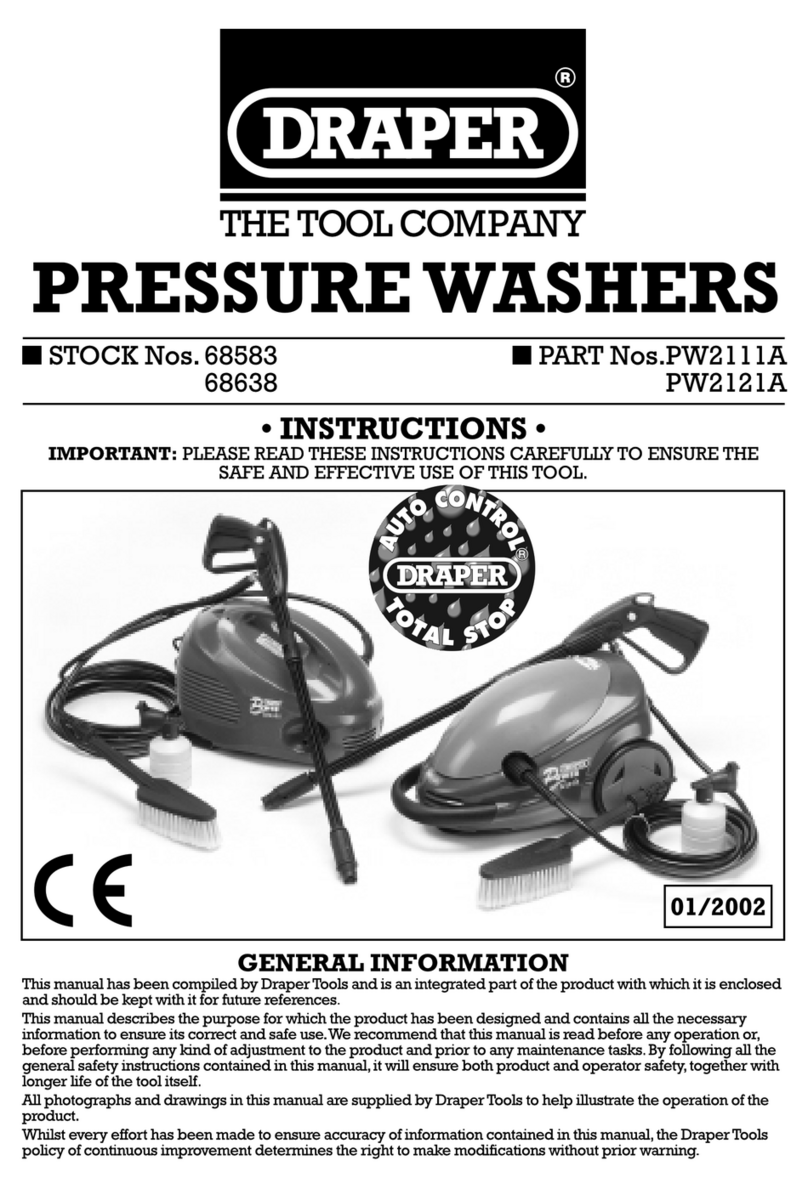
Draper
Draper PW2111A User manual

Draper
Draper PW2810 User manual
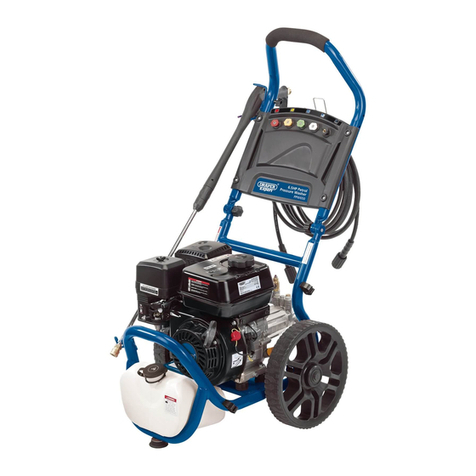
Draper
Draper PPW650 User manual
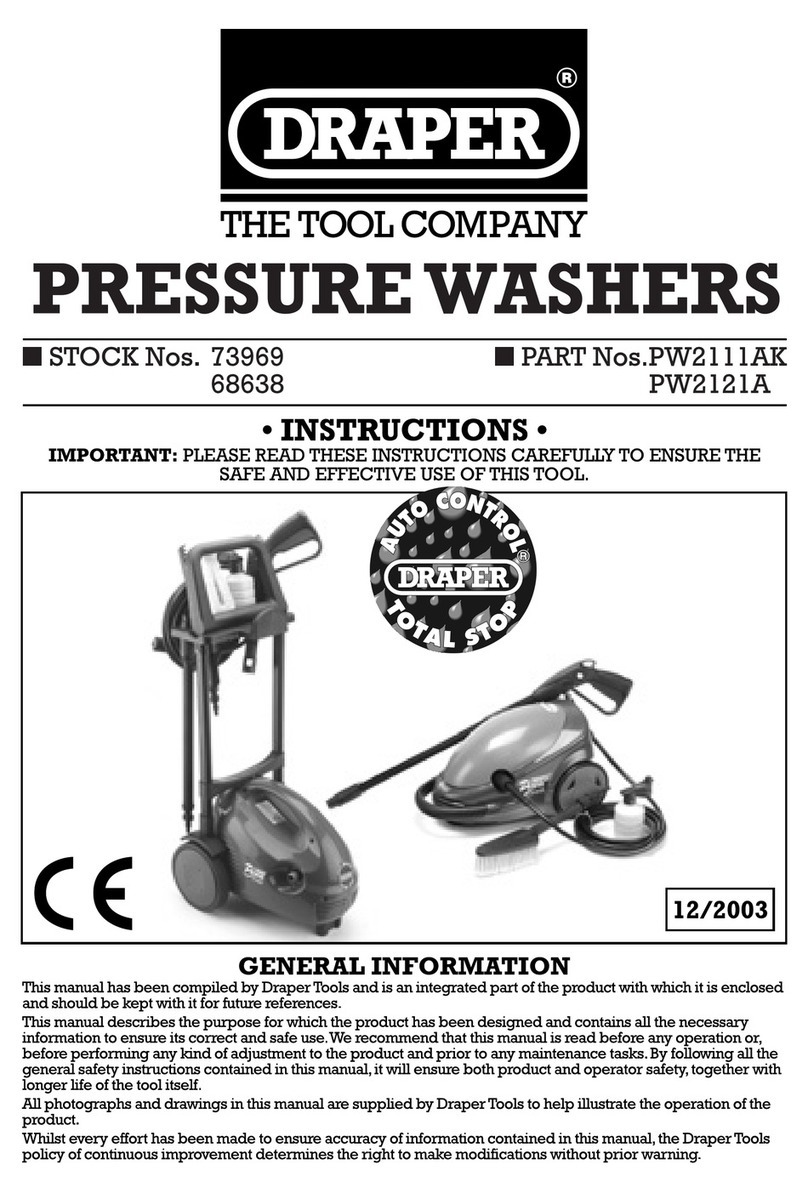
Draper
Draper PW2111AK User manual

Draper
Draper 98678 User manual

Draper
Draper PW1730 User manual
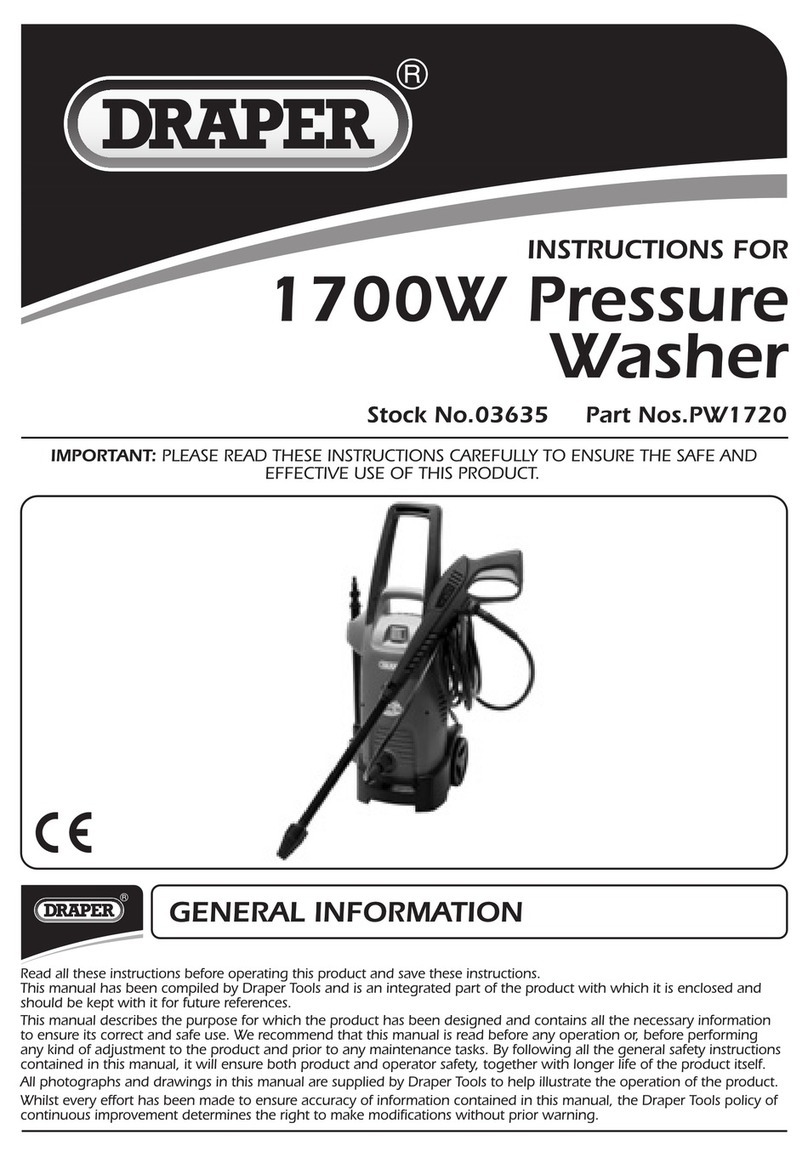
Draper
Draper PW1720 User manual

Draper
Draper 34390 User manual
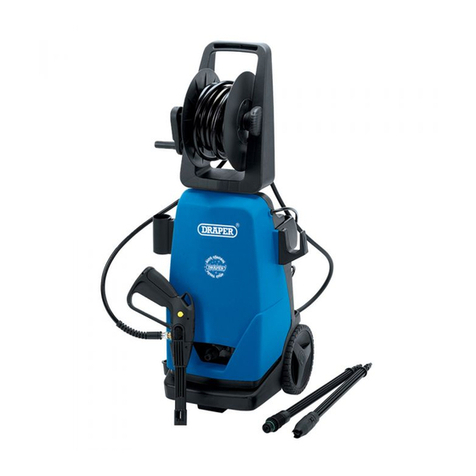
Draper
Draper PW2000 User manual
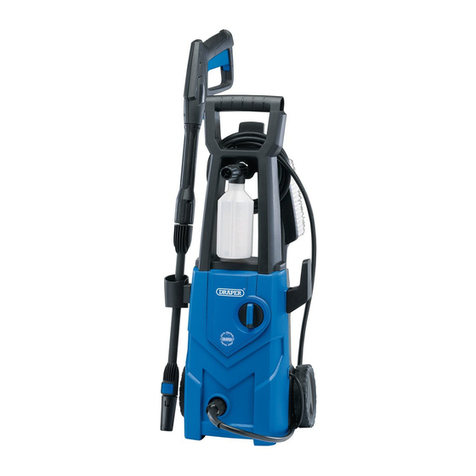
Draper
Draper 98676 User manual

Draper
Draper PPW540 User manual
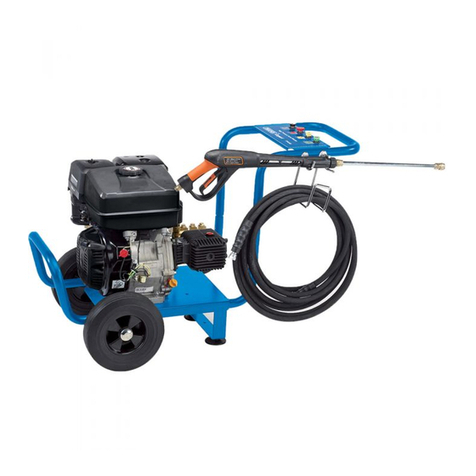
Draper
Draper PPW900 Firmware update

Draper
Draper 41401 User manual
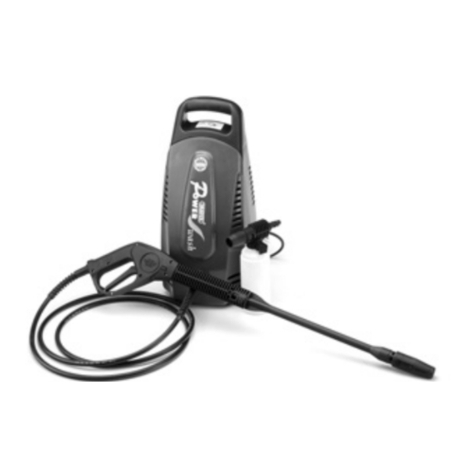
Draper
Draper PW1600A User manual

Draper
Draper HPW2110 Firmware update
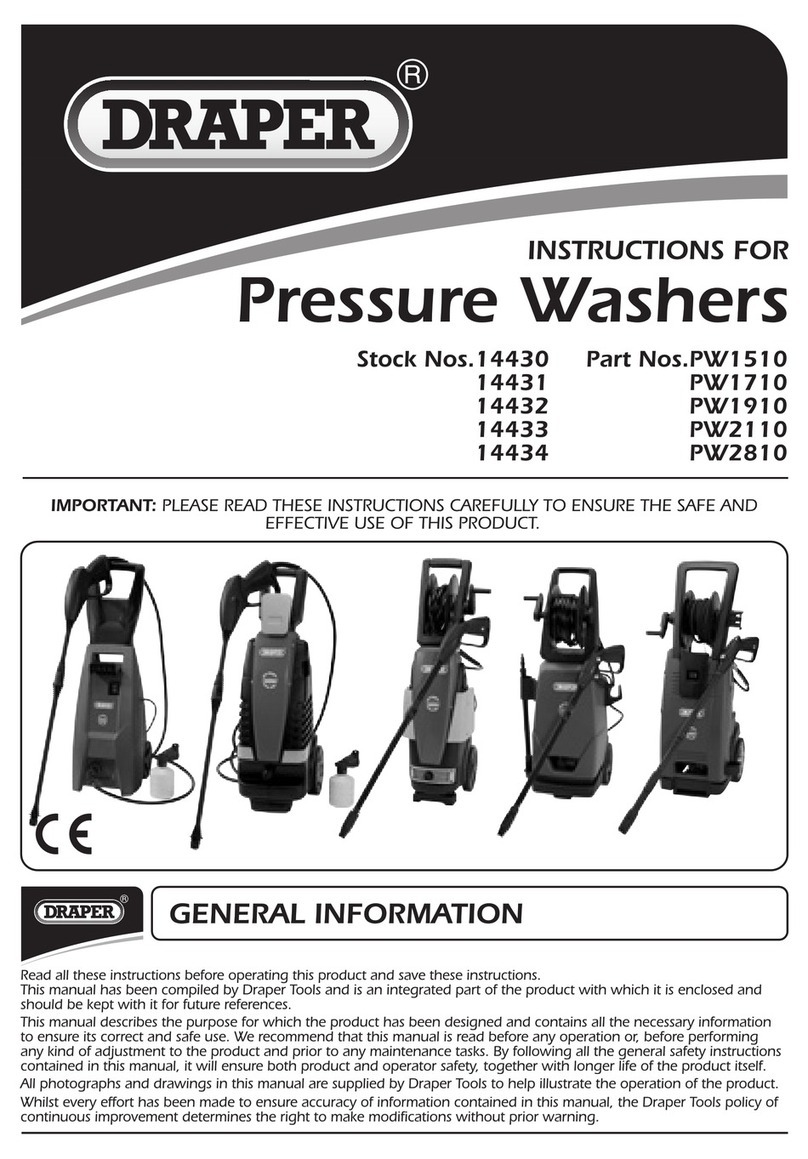
Draper
Draper 14430 User manual
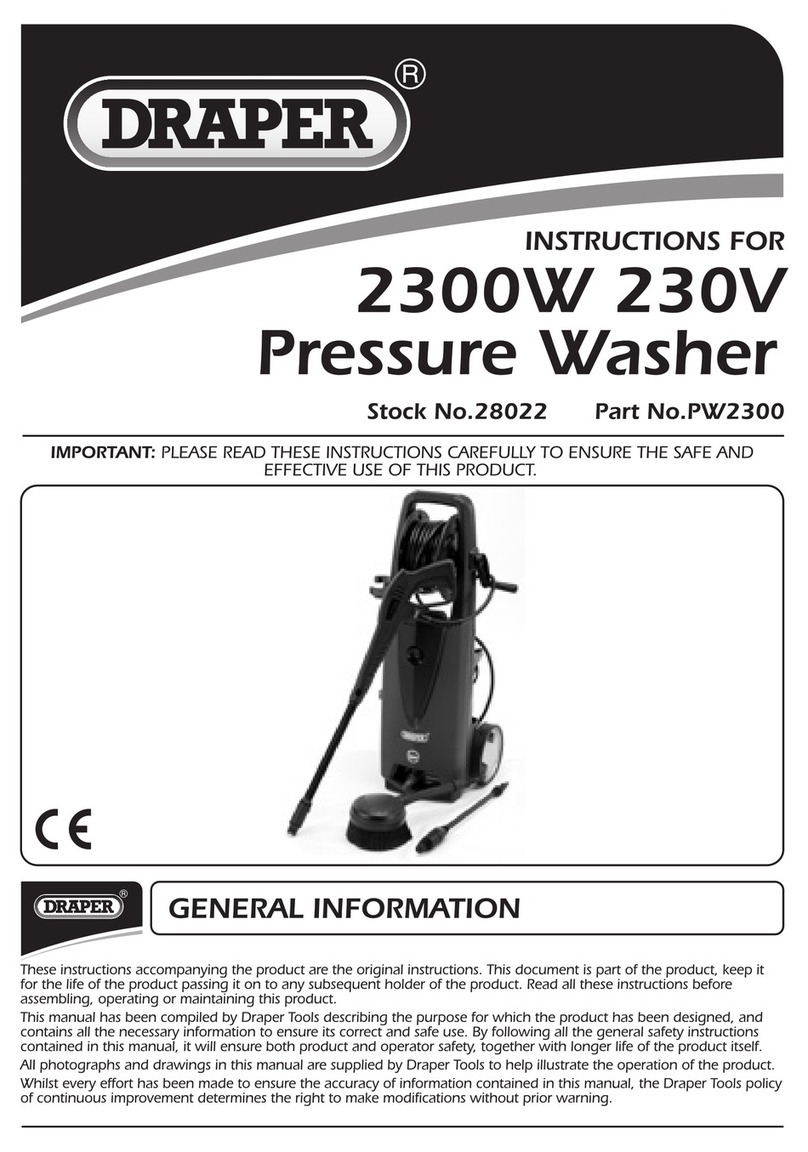
Draper
Draper PW2300 Firmware update
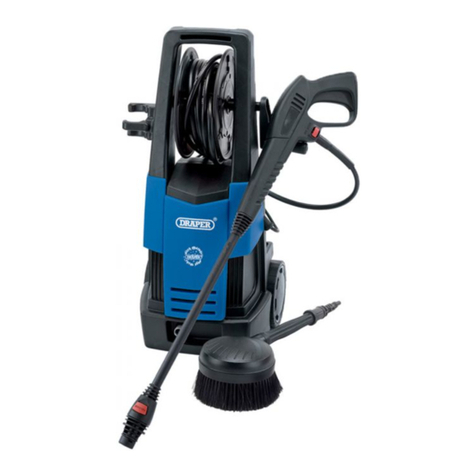
Draper
Draper PW1920 Firmware update

Draper
Draper 2200W Firmware update
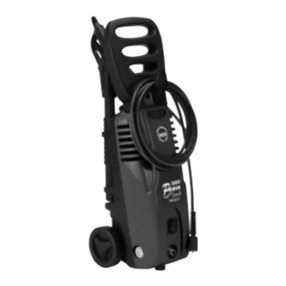
Draper
Draper PW2210 User manual

